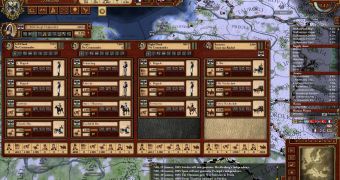March of the Eagles can be an unforgiving experience, especially for the first few games, when a player figures that he can succeed based simply on his knowledge of history and understanding of military strategy, acquired from other games series.
I have both of the above, and my initial campaigns as Prussia, Austria, Russia and France were pretty dismal failures, with my nation forced to bend the knee against its enemies and sign peace agreements that left almost no hope at overall victory.
My biggest problem was that I was not paying enough attention to the composition of my armies, the selection of my commanders and the tactics that I used while in the field.
I suggest to all those who launch March of the Eagles to choose their country and then refrain from pushing the button that starts the flow of time in the scenario.
Once they do that, they will be able to simply choose an army, preferably the biggest they have on the map, push the button in the lower right of the panel that pops up and then simply look at the interface.
This is, to me, the most important part of March of the Eagles, the section of the game that can make or break a campaign.
Here, players can choose commanders for their armies and sub-commanders for each flank, and they can tweak the layout of their army before deciding which tactic it will try to employ on the battlefield.
The choice here is based on many elements: where the battles are expected to take place, how long the campaign could go for, what types of enemies can pop up, the abilities of their commanders.
I spent a lot of time evaluating the tactical options in March of the Eagles and I still have a lot to discover about their effects and how to best employ them to defeat my enemies.

 14 DAY TRIAL //
14 DAY TRIAL //